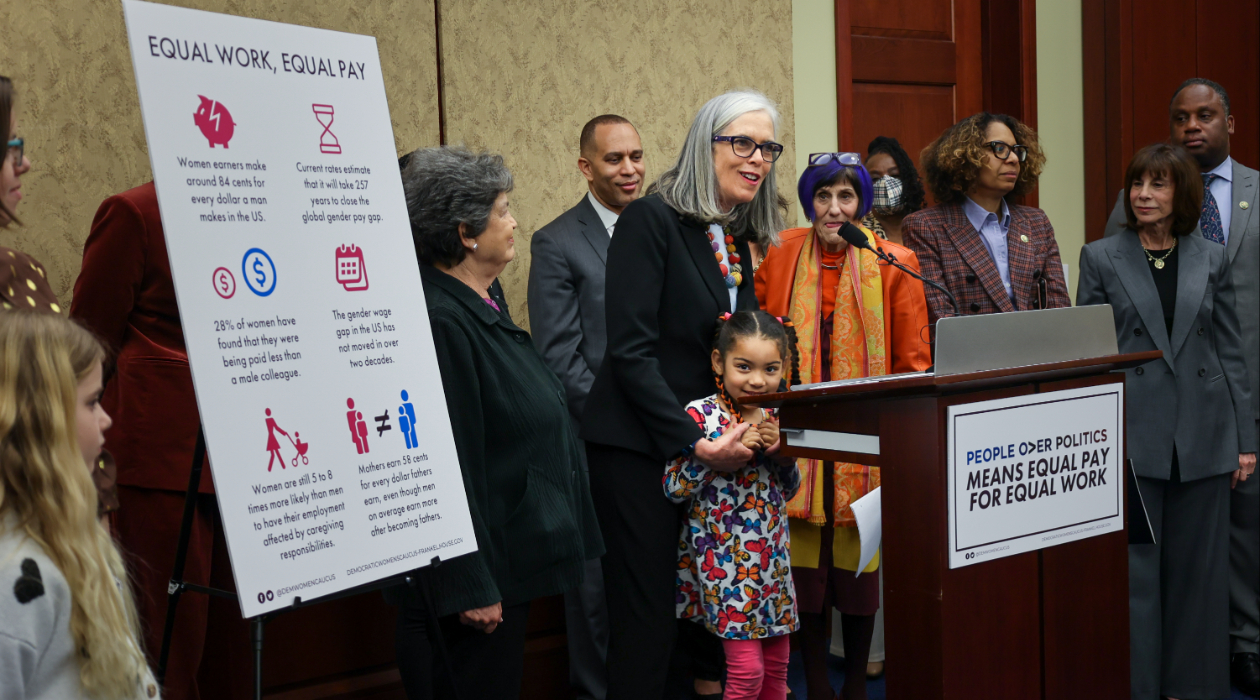
WASHINGTON—Equal Pay Day arrived on March 14 with the pay gap still yawning between working men and working women, adjusted for occupation, education, and qualifications.
And it came with Democratic congresswomen, led by House whip Katherine Clark of Massachusetts and longtime equal pay advocate Rosa DeLauro of Connecticut, vowing to again push legislation to close the chasm.
“Today, Democratic Women’s Caucus leaders joined @RepJeffries, @WhipKClark, and @SpeakerPelosi for a press conference in advance of #EqualPayDay,” DeLauro tweeted. “Women deserve equal pay for equal work, plain and simple.”
The group once again pushed DeLauro’s Equal Pay Act, which would renew the strength, diluted by courts and corporate opposition for 60 years, of a 1963 equal pay law.
It would ban bosses from shutting workers up who want to discuss pay with each other and force firms to prove unequal pay is really based on business reasons, not discrimination favoring white males.
But in all the statements and studies one obvious equalizer was completely overlooked: Unions.
The overall pay gap between the median wages of working women versus working men, adjusted for occupation and education, is 82 cents on the dollar, Clark reported. That figure has remained relatively static for 20 years, ranging from 77-82 cents. Median pay is the point where half the workers earn more and half earn less.
It also means a working woman, at her median wage, had to work all of 2022 and up to March 14, 2023, to match the median pay of a working man for last year. It takes even longer for working women of color to catch up: Latinas earned 54 cents on the dollar, said Clark and Black women earned 64 cents.
There’s a median pay gap between union men and union women, too: 90 cents for a working union woman for every dollar a working union man makes. That’s the same ratio between non-union workers, too, calculations from Labor Department data for 2022, released earlier this year, show. The big difference is the medians themselves.
The median weekly pay for all workers in 2022 was $1,059. For all working union men, it was 20% higher, at $1,273. For all working union women, it was $1,146, 8% higher. The 10 cents-per-dollar lag for unionized women came in the gap between those two groups’ median weekly pay: $1,273 (men) versus $1,146 (women).
The non-union working women trailed far behind. The median pay for working non-union men was $1,029, $30 less than the median for all working men. But the median for non-union working women was $932 per week—$127 behind.
Clark concentrated on the pay chasm between working white men and working women. “That kind of ingrained, widespread injustice leaves everyone worse off. It means tighter family budgets. It means an economy and a country that can never reach its full potential,” she said.
“Half a century ago”—actually 60 years ago this June—“President Kennedy signed the Equal Pay Act. Decades later, President Obama signed the Lilly Ledbetter Fair Pay Act. And now, Rosa DeLauro is leading the charge, and it’s time to send the Paycheck Fairness Act to President Biden.”
Another study, by Amanda Martin-Caughey of the Census Bureau, disclosed yet another reason for unequal pay for equal work. Except for teachers, whose median yearly pay in 2021, the last year she had data for, exceeded $55,000, “women’s work” had dramatically lower median pay than majority-male occupations.
And while more men (2.7 million) than women (1.7 million) permanently lost jobs during the coronavirus pandemic, she reported the job losses were proportionally higher in female-dominated occupations.
The biggest job loss was among maids and housekeepers, 83% of whom were women, and more than 200,000 (31%) of those workers of both sexes lost their jobs—which didn’t pay as much to begin with: a $25,513 median for female workers in those jobs. They outearned only women cashiers, child care workers, who were second to last at $25,241, and cooks ($24,030).
Some 94% of childcare workers were women, and 23% of all childcare workers lost their jobs when the coronavirus pandemic closed childcare centers, sent parents to work at home, or both.
But the pay gap was evident even in higher-paying jobs which added workers during the pandemic, Mertin-Caughey reported. Her example was business operations specialists, a high-skill and majority-male field. It added almost 100,000 workers during the pandemic, both men and women, ‘but the 2021 women’s median earnings were $60,982, compared to men’s $80,204.”
“We cannot ask women in this country to endure this injustice decade after decade while offering only encouraging words and empty promises. We need to speed up the pace of policy change on this fundamental issue and the Institute for Women’s Policy and Research is committed to doing just that,” said CEO Daisy Clin-Lor.
“Of the 20 largest occupations for women studied as part of IWPR’s research, the three with the worst pay inequities were: Financial managers, where women only earn 69% of what men earn, a retail salesperson at 76.5% and retail supervisor, 78.3%,” reported Daisy Chin-Lor, CEO of the Institute for Women’s Policy and Research. “There is only one occupation—teaching assistants—where women and men were paid exactly the same.”
Another reason the pay gap may be understated is that many big firms keep the lid on pay data, said Michael Passoff, CEO of Proxy Impact, a non-profit that tracks shareholders’—including unions’—proxy wars to force the corporate class to come clean about its pay, perks, pay equity and other issues.
Of the 68 largest firms Eskoff’s study covers, 25 refuse to disclose pay data, in some cases despite past promises to do so. It then becomes tough to gauge gaps at those firms, he said. The offenders include Alphabet (parent of Google), Goldman Sachs, Marriott, Charles Schwab, and Walmart.








